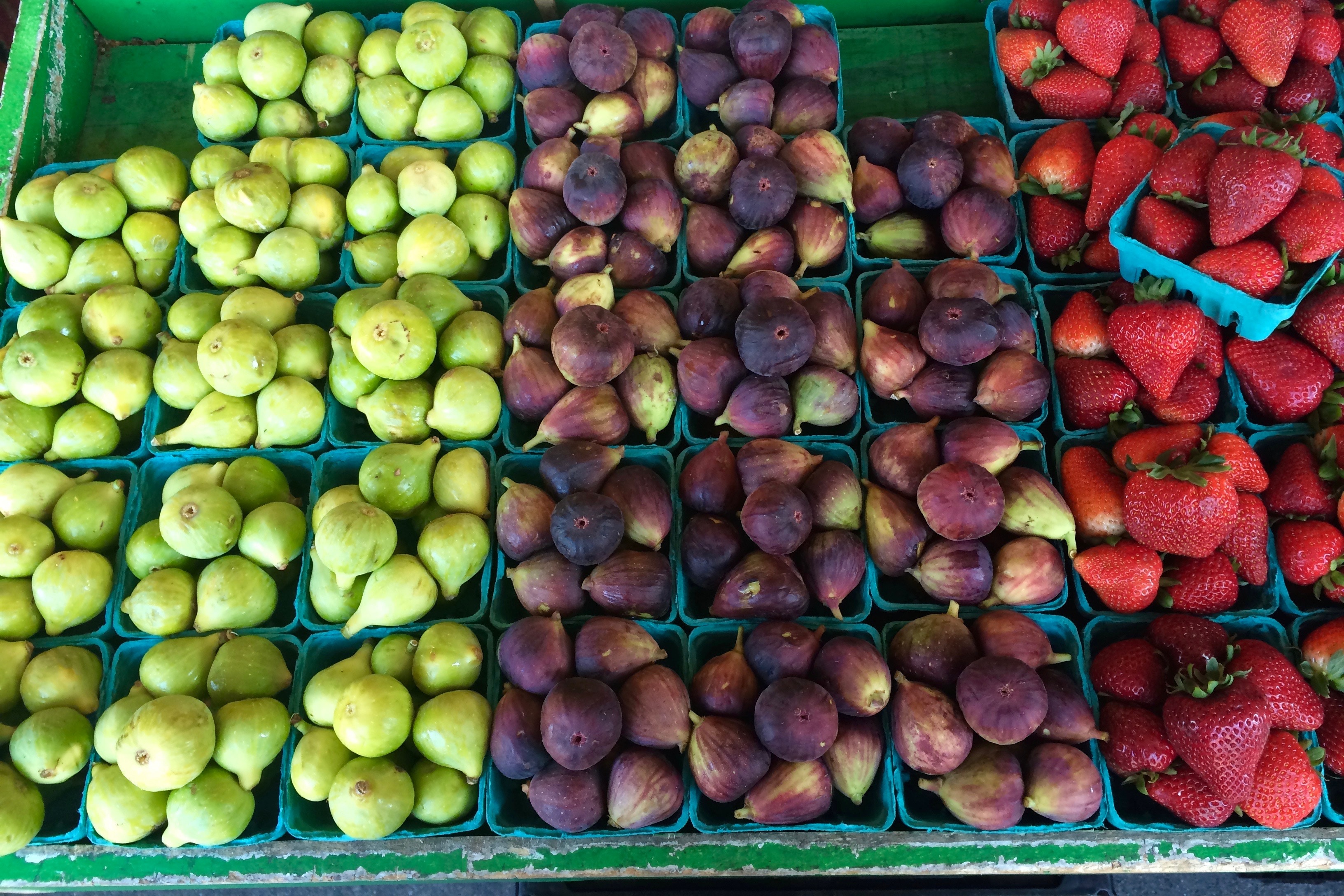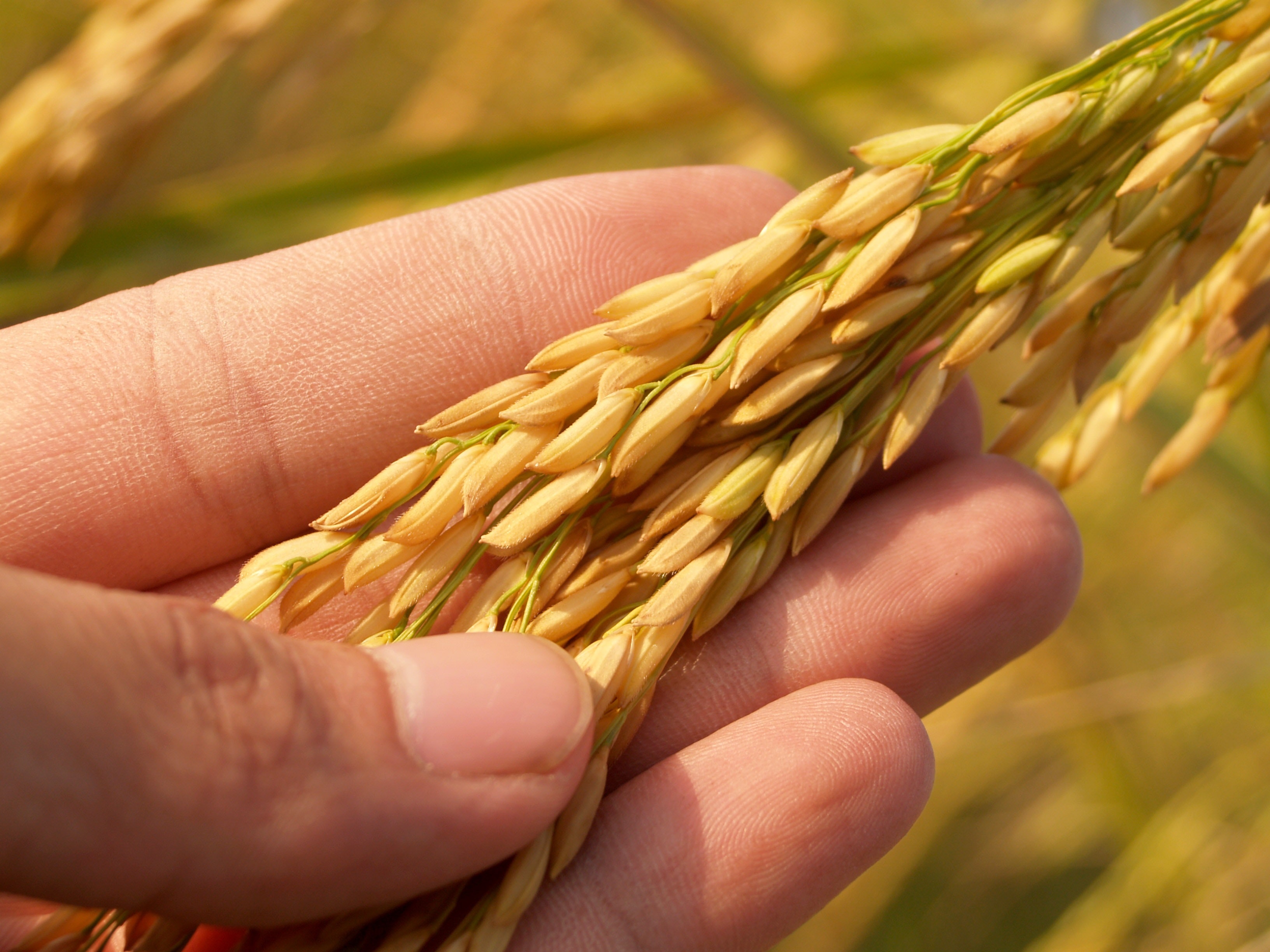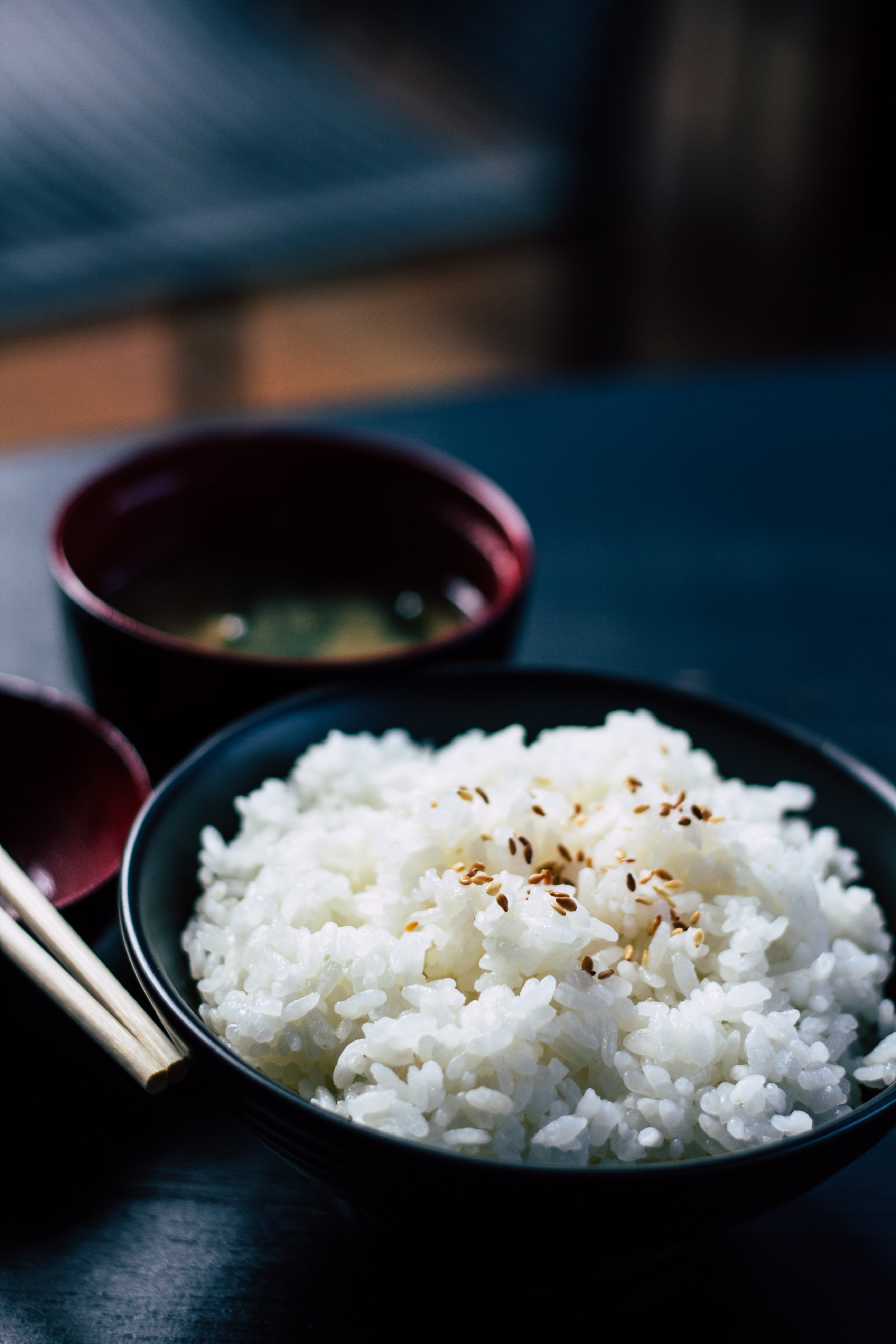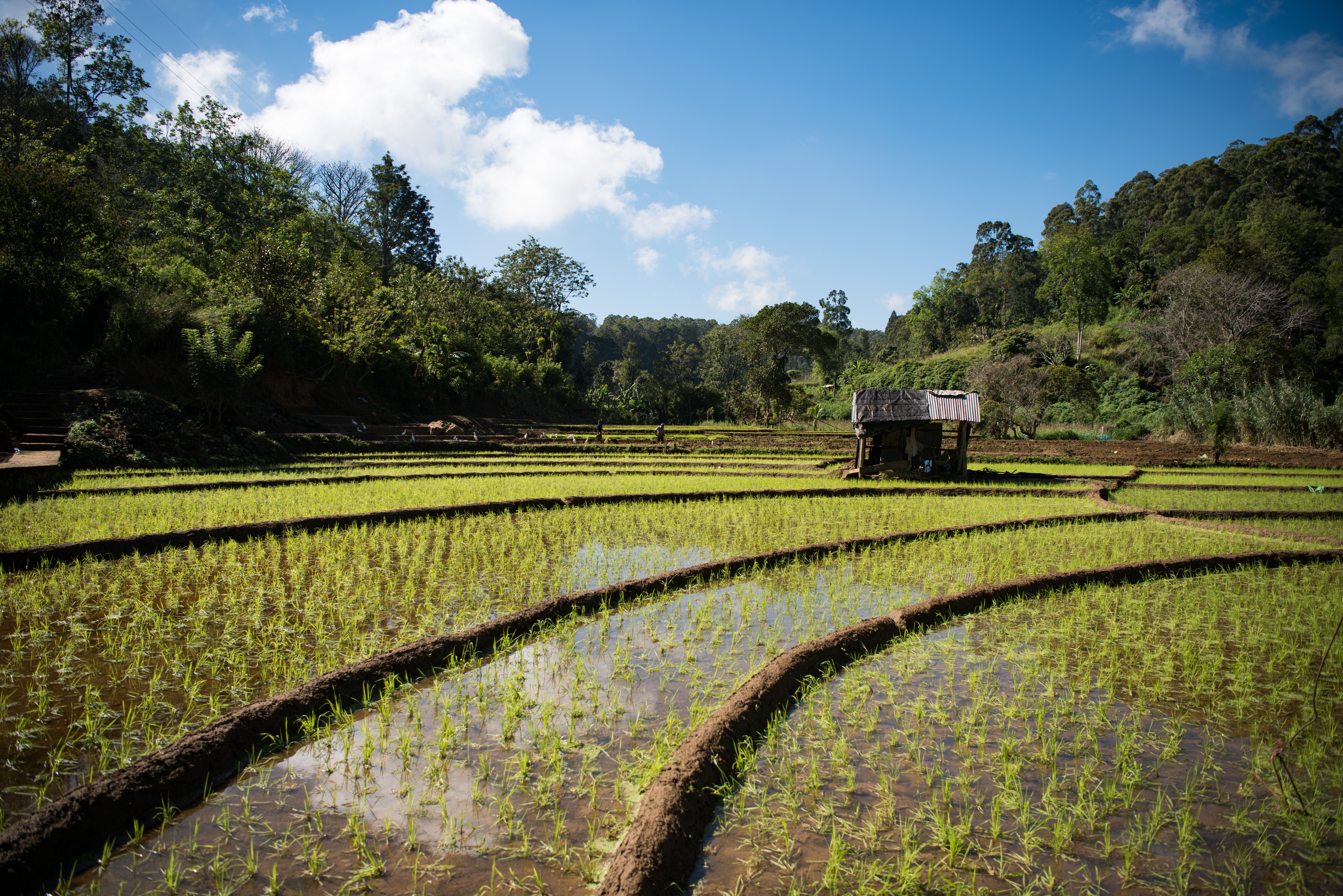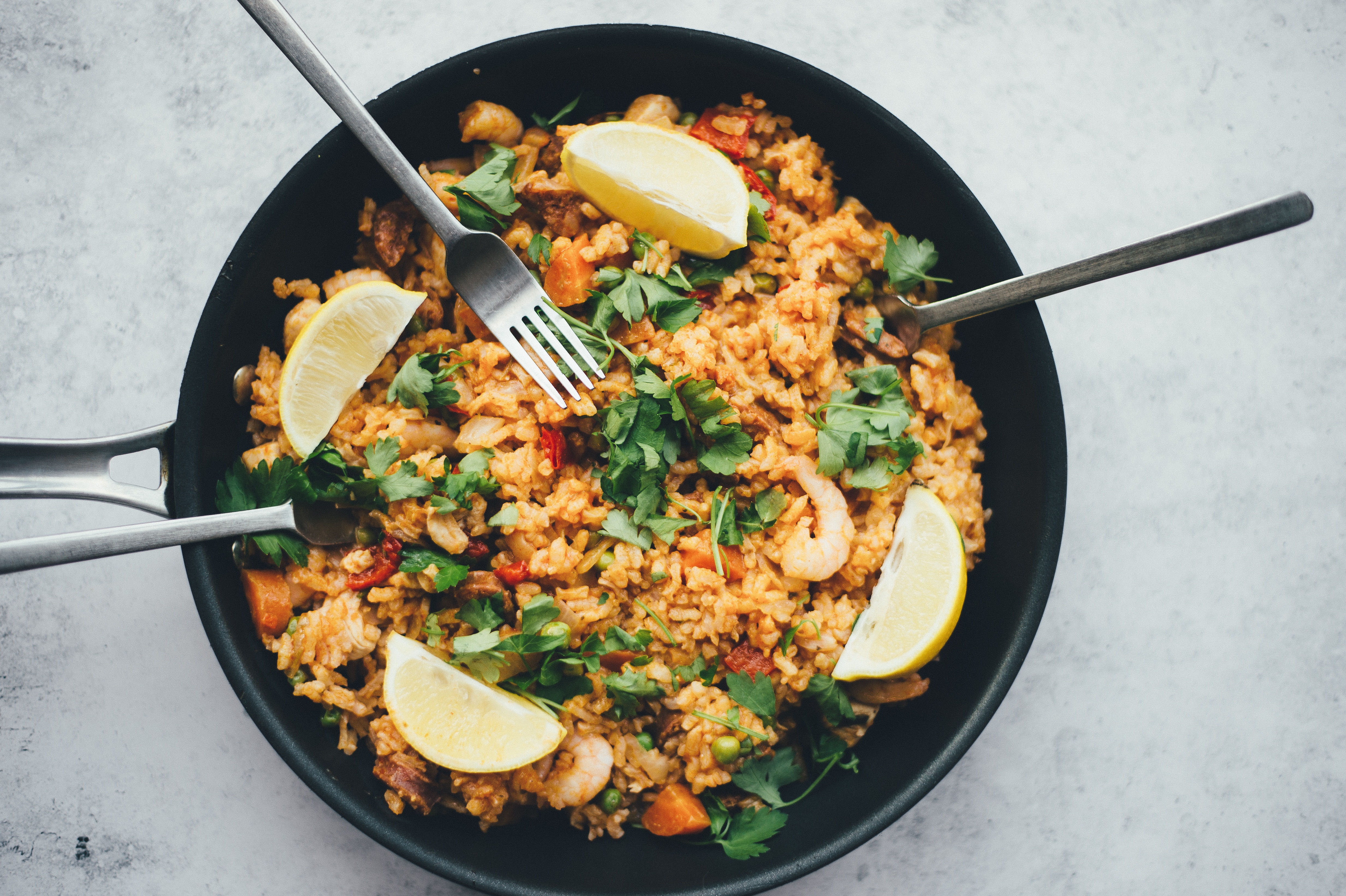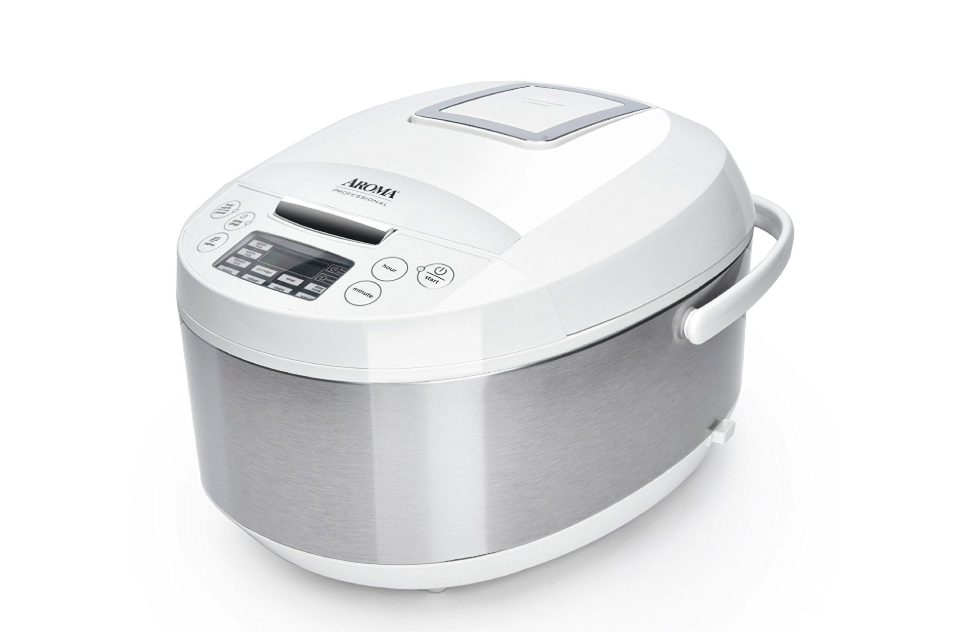In the world of modern nutrition, the debate between white and brown rice seems long put to bed.
Brown rice is soooo obviously healthier… right?
Why have we come to this conclusion? Let me count the ways:
First of all, something that’s brown in color is always healthier than something that’s white (duh, Dr. Liz).
White means something is refined, devoid of nutrients, and I shouldn’t eat it, like bread and pasta.
So brown rice has more… stuff, right? More nutrients and minerals?
Plus white rice will definitely spike my blood sugar because it doesn’t have much fiber. That’s why I slog my way through that chewy outer layer, right? RIGHT?
These might indeed be the reasons why you feel the need to eat brown rice.
But I’m here to say CUT IT OUT.
I know this might be a shock — a professional in the natural health world is telling you to eat a white and “more refined” food.
But not all white foods are bad for you (like organic potatoes), just the ones we’ve monkeyed with recently so that they barely pass for food anymore. I’m looking at you, white sugar, conventional/GMO potatoes, GMO corn, white/refined salt, and overly glutinous and hybridized, GMO/pesticide laden white flour.
So I’m going to set the record straight.
Eat white rice. For your nutrition, gut health, and tastebuds.
I eat white rice all the time. I tell my patients to eat white rice.
It’s affordable, easy to cook, and a great source of starch and carbohydrate. Not to mention a very large percentage of the planet eats it daily to maintain their health.
Here’s another bomb in the face of modern nutrition: carbs are healthy!
Especially for women with mood issues or who are trying to get pregnant.
White rice is a perfectly nutritious choice.
It’s the better choice.
Not convinced yet? I don’t blame you. Let’s get into why white rice is definitively the healthier option.
We’ll look at this issue through two lenses: modern and traditional nutritional practices.
Modern Nutrition
#1 Fiber
Let’s define the difference between white and brown rice a little more.
White rice is simply the grain with the bran and germ removed. Brown rice has the bran and germ in tact and is a “whole grain” by our definition.
Ooo… you said bran… that means fiber! And fiber is sooo healthy for you! So brown rice IS better!
You are definitely correct in that the bran of the brown rice includes fiber, and that as a result brown rice has more fiber than white rice.
However, fiber is not all it’s cracked up to be. I know, I know, blasphemy in the nutritional sphere!
It matters what kind of fiber you’re getting: soluble or insoluble.
Soluble fiber is soft, gentle, and bulking fiber that adds volume to your stool. It’s found mainly in fruits and vegetables.
Bulk is important because it activates stretch receptors in your gut. These receptors register the matter in your large intestine and trigger peristalsis, or rhythmic contractions along your intestines to move food through.
Soluble fiber forms a gel with water in your digestive tract and helps to slow transit time through the bowels, preventing blood sugar spikes, lowering cholesterol, and allowing adequate time for mineral and nutrient absorption.
Note: slowing things down DOES NOT mean soluble fiber is constipating. It means we actually have a chance to digest what we’ve eaten, as opposed to highly refined foods with no fiber content. They’re the ones that go right through our systems and cause blood sugar spikes and other metabolic issues.
Soluble fiber also feeds your good gut bacteria by fermenting in your large intestine — yay!
Insoluble fiber is harsher on the GI tract and moves food through more quickly.
Insoluble fiber does not ferment anywhere in your gut and is not broken down at all. It also adds water content to your stool to increase bulk.
This might sound great if you have constipation, but there are many, many other reasons for constipation that are often simplified down to a need for fiber, like hormones, food allergies, gut inflammation, thyroid issues and more.
Fiber is definitely important to health, but it’s important to choose the right kind of fiber, especially if you have an active inflammatory gut condition.
Insoluble fiber is very irritating to a sensitive gut lining and can increase gas, bloating, pain, and other uncomfortable symptoms in healthy folks, and even more so in those struggling with inflammation in their digestive tract already.
Brown rice is high in harsh, irritating insoluble fiber.
White rice is not.
I have seen brown rice be very difficult to handle for my patients with gut issues.
It’s better to focus on soluble fiber foods that feed your gut health.
If constipation still remains, it’s time to look into other causes instead of piling on more fiber from a supplement that can be overly harsh.
Find a list of soluble and insoluble fiber foods in foods here.
And in general, I’d avoid irritating your GI tract with bran products… I’m looking at you bran muffins and Fiber One cereal.
Stick with soluble fiber and your gut will thank you.
#2 Phytic acid
This is another baddie found in that brown rice bran and other whole grains.
Phytic acid is known as an anti-nutrient.
Why?
Because it binds to minerals like zinc, iron, calcium, and manganese and blocks their absorption.
The bran of brown rice does have a few nutrients, including magnesium, phosphorus, selenium, thiamin, niacin, vitamin B6, and manganese.
However, if the bran is minimally digested because it’s composed of insoluble fiber AND is high in phytic acid, just how many of those nutrients are we actually getting?
In the natural health world you see folks soaking and sprouting their grains to minimize phytic acid.
So… wouldn’t soaking and sprouting your brown rice minimize the phytic acid content?
Not necessarily, according to Ramiel Nagel, author of Cure Tooth Decay (a wonderful book on preventing dental issues naturally — it all starts with what you eat!).
Ramiel states that brown rice’s phytic acid levels aren’t really affected by soaking and sprouting. An interesting study published in the International Journal of Food Sciences and Nutrition compares the iron absorption between brown rice and milled rice (bran partially removed through processing) and found no significant difference.
The study authors note that brown rice contained a significantly higher amount of iron than the milled rice.
So what gives?
Phytic acid blocking the absorption of iron.
You can find plenty of articles on the interwebs about phytic acid and that it doesn’t necessarily harm us. It even has some health benefits.
I’m not saying phytic acid is the worst thing ever.
But if we’re eating a diet high in processed foods with minimal nutrient content, are chronically stressed out, have a chronic inflammatory condition, are exposed to tons of toxic chemicals daily, and our food doesn’t have the nutrient content nowadays that it used to because of soil depletion, we’re probably close to running on empty mineral-wise.
Most people I see are mineral deficient. Even those who eat well.
Whatever we can do to preserve and increase our mineral load will help us out a ton and brown rice is not assisting us in that regard.
If you want to know more about tooth decay issues, check out the Weston A. Price Foundation.
#3 PUFAs
What about the germ part of brown rice, Dr. Liz? That has to be good for us, right?
Sorry to disappoint you… again.
The germ has oils that can be ok for your health, but unfortunately they are very prone to rancidity.
The oils are PUFAs or polyunsaturated fatty acids. Their chemical structure is inherently more unstable than saturated fat (which, by the way, is good for you!), making them easy to oxidize, which in turn promotes inflammation.
Some PUFAs are good for you, and some in small quantities are fine, but many of us get way, way too much of the really crappy ones.
The two types of PUFAs are omega 3 and omega 6 oils.
Omega 3 oil is largely regarded as anti-inflammatory and we seek it out in oily, cold water fish like salmon, cod, sardines, and anchovies, and fish oil supplements.
Omega 6 oil is naturally found in small quantities in many foods like nuts, seeds, legumes, and well-raised/chemical and hormone free animal products.
Unfortunately, an abundance of omega 6 PUFAs are found in processed foods (even organic ones) because they are cheap and readily available: corn, soy, canola, vegetable, and cottonseed oil are extremely high in PUFAs.
Just check that nice Newman’s Own or Annie’s Organic salad dressing you’ve got. Crappy, easily oxidized oils abound!
Omega 6s aren’t inherently evil, depending on their source. Whole food sources = awesome. Processed oils mentioned above = avoid like the plague.
It’s just that they’re everywhere nowadays and we get way too many of them, which contributes to lots of inflammation and other gnarly stuff. For a more in-depth read on PUFAs, check out this article.
If you’re eating a great diet low in omega 6 PUFAs, the amount in brown rice won’t hurt you, unless it’s rancid.
How do you tell if your brown rice is rancid? There’s usually a bitter aftertaste.
To prevent rice from going rancid rapidly (or rodents/bugs getting into it), rice eating cultures would store the rice either in its husk or as white rice.
Our ancestors were super smart!
#4 Glycemic Index
Brown rice’s glycemic index has to be better than white rice’s glycemic index, right? I’ve heard that. White rice really spikes your blood sugar.
Let’s unpack this a little.
Glycemic index is a measure of your blood sugar after eating a certain food.
If the glycemic index of a food is high, it means that the food is digested quickly and spikes your blood sugar. A lower glycemic index food is digested more slowly and has less impact on your blood sugar.
So… what’s the difference between white and brown rice, you ask?
Here’s the breakdown, including several varieties of white rice:
Rice Type |
Glycemic Index |
| Sushi rice | 88 |
| Short grain white rice | 72 |
| Jasmine rice | 68 |
| Long grain rice (e.g., basmati) Brown rice | 59 |
| Brown rice | 55 |
So…. you can see that brown rice really isn’t that different from some forms of white rice.
Also, we need to stop for a minute and talk about the glycemic index of foods and its importance… or unimportance.
It’s important to understand that the glycemic index is a measure of a SINGLE food’s blood sugar response in the body.
Let me ask you — how often do you sit down and eat plain bowl of white rice?
I’m gonna go ahead and guess you’re somewhere between “only if I’ve completely run out of food” and “never”.
What’s much more important than the glycemic index of a single food is how your body responses to the entire meal.
We naturally want to add flavorings, fat, and protein to round out the rice in our meal. These additions will shift the glycemic index, most likely to something much lower (depending on your additions).
Bottom line: I wouldn’t get too freaked out about the glycemic index of whole, minimally, or unprocessed foods.
Get freaked out with processed crap and maybe a little concerned if you have a tendency to eat a healthy food with a higher glycemic index all by its lonesome. And if you do, just add some fat.
#5 Arsenic
Hey Dr. Liz, can't rice have high levels of arsenic? Does that include brown rice?
Yes.
Brown rice is more contaminated with arsenic than white rice, actually.
The arsenic accumulates in the bran, which has been stripped away in white rice.
Why does rice accumulate so much arsenic in comparison to other grains?
There are several reasons, one being that it’s very, very good at sucking the stuff up.
Another is that rice is often grown on old cotton fields, and cotton pesticides commonly contain arsenic.
Land used to raise chickens can also be high in arsenic because conventional chicken feed adds arsenic to fatten the animals up.
Seriously people, what kind of f***ed up world are we living in that we feed poison to animals? We give them an awful quality of life then we magically think that all of the sh** we feed them won’t end up in us.
If you want to reduce arsenic risk in rice, here’s your game plan:
#1 Buy organic from trusted brands. I like Lundberg rice, farmed in California. They independently test the levels of arsenic in their rice and publish the results.
#2 Soak your rice. A study showed that soaking rice overnight reduces arsenic levels by 80%.
If you want to read a more comprehensive blog about arsenic levels in rice, check this out.
Traditional Nutrition
#1 Wisdom over millennia
All right, let’s check out why white rice is awesome from a traditional perspective.
First of all, it provides a hearty, filling starch and is easy to cultivate. About 50% of the world’s population eats white rice as their staple food.
And guess what? Cultures that still have traditional diets (i.e., not infiltrated with Western processed crap) tend to eat high starch foods and have no blood sugar, insulin resistance, or other common health problems we find in the Western world.
"There are literally billions of people eating high-starch diets worldwide, and you can find many examples of cultures that consume a large percentage of calories from starch where obesity, metabolic problems and modern, inflammatory disease are rare or nonexistent. These include the Kitava in the Pacific Islands, Tukisenta in the Papa New Guinea Highlands and Okinawans in Japan among others. The Kitavan diet is 69% carb, 21% fat, and 10% protein. The Okinawan diet is even more carb-heavy, at 85% carb, 9% protein and 6% fat. The Tukisenta diet is astonishingly high in carbohydrate: 94.6% according to extensive studies in the 60s and 70s. All of these cultures are fit and lean with low and practically non-existent rates of heart disease and other modern chronic disease." Chris Kresser, LAc, author of the Paleo Cure
I’m a big fan of carbs and they’re a very important part of health, especially for women. Women are more sensitive to serotonin swings than men, and a lot of our serotonin production is activated by eating carbs.
Carbohydrates are also an important part of stimulating the HPA axis (hormonal control center in the brain) to trigger ovulation.
My own personal journey with white and brown rice started back in 2003. At the time, my boyfriend was Korean and he always had white rice with a little bit of barley cooked up in a rice cooker.
He was a healthy weight, didn’t have blood sugar issues, and had been eating white rice at most meals for his entire life.
It didn’t really occur to me that white rice might be “unhealthy”, as I could look to him, his family, his culture, and many, many other cultures with a long history of eating white rice.
When I moved out to Seattle in 2006 for medical school, all of a sudden, brown rice was everywhere. It’s all they served in the cafeteria at my school and you could order it in any restaurant.
I went with the brown rice trend for a bit, but… it just wasn’t that good. The chewy texture was kind of fun, but the digestive upset afterward from too much insoluble fiber was not.
But it was “healthier", so I ate it.
Annnnd, then I stopped.
I knew I enjoyed white rice more and I continued to think about the traditional wisdom of so many cultures all over the world in eating white rice for millennia.
Back before industrialization, anything in life took a significant amount of time, effort, and energy: hunting, gathering, farming, building, fabricating tools and supplies, the list goes on.
So why, if energy and time were at such a premium, did all of these cultures go to the effort of taking the bran and germ off of the rice?
I came to the conclusion that they knew something I didn’t.
I’m much more willing to trust thousands of years of tradition over any bright-shiny-new nutritional wisdom that gets spouted in a rotating fashion depending on the decade you’re in.
Phytic acid, PUFAs, glycemic index, whatever. They support my hypothesis for the most part, but I’ll give the most credit to the people who figured out without nutritional science as we know it that white rice is better for us.
#2 Cooking methods
In 2015, the Washington Post came out with an article exclaiming that scientists have discovered a simple way to cook rice that dramatically cuts calories.
Let’s be clear: these dudes might have discovered that adding oil to rice cuts down on what we in the Western world are all strangely obsessed with — calories, but they certainly didn’t discover that adding oil or fat to rice was beneficial to health.
Cultures around the world have been doing this forever.
Look at fried rice in China or Thailand, or basmati rice recipes in Indian cuisine with peas, onions, and oil. The list goes on.
Maybe these people didn’t know that this combination cut calories (which, by the way, doesn’t really matter as much as we think it does in weight loss), but they knew it tasted and felt good to eat.
The article also points out that it’s wise to eat reheated starches, including rice, because the type of starch present is transformed into what’s called resistant starch.
Resistant starch has less impact on your blood sugar due to the chemical transformation that happens when starch is cooled. The same is true for potatoes, sweet potatoes, and more high starch foods.
I’m pretty sure early peoples weren’t opposed to eating leftovers.
The article also strangely insinuates that rice has something to do with the obesity issue affecting rice-eating populations, though it does admit other things could be contributing.
Yeah…
The problem isn’t white rice. The problem is disgustingly processed and unnatural Western foods making their way into the diet of the world.
But apparently we can’t possibly point the finger back at our overweight selves and comprehend that our terrible food quality is making us fat and everyone who comes into contact with it.
End soapbox.
#3 Easy to digest
A wondrous property of white rice that seems to have escaped modern nutrition is that it’s very easy to digest.
We’ve already established that it doesn’t mess with your blood sugar a ton, so don’t let that easy-to-digest statement bother you.
What’s the benefit of this easy to digest business? Don’t we want our digestion to work a bit so it burns more calories and nets us more nutrients?
Emphatically no.
There’s already enough work that goes into breaking down and processing food.
Let’s eat things that make it easy for the body to acquire the nutrients we need so we can spend our energy on other things… like building tiny replicas of Miami Beach circa 1980 in glass bottles. What? Everyone needs a hobby!
White rice is extremely therapeutic in a medical context for its easy to digest nature.
It’s a food that we gravitate toward when we’ve got a cold or our stomach and guts are upset.
Chinese medicine views food as medicine, and they created a perfect food called congee for upset digestive tracts and feeling under the weather.
It’s essentially rice porridge, made with stock or water (though I’d recommend stock so you get lots of extra minerals and nutrients), and is essentially a blank canvas.
When you’re feeling better, add shredded chicken, sesame oil, green onions, or go sweet with cinnamon and raisins.
Brown rice is awful to eat when you’re sick because the bran is very irritating.
Part of Chinese medicinal nutrition is assigning energetic temperatures to foods and understanding how they interact with our own internal energetics.
White rice is a neutral temperature, making it the perfect vehicle to add ingredients to warm you up if you have a cold pathogen or digestive issue (like ginger), or adding cold herbs and foods (like mint or seaweed) if you have a heat pathogen or digestive issue.
Congee is at the top of my list whenever I’m feeling under the weather. Find a great recipe for it here.
Ok, I hope I’ve convinced you of the merits of white rice!
I wanted to include a few practical tips and resources for you now that you’ve got the rice bug, like how to select white rice and how to cook it.
How to select white rice
We touched on this a little in the arsenic section, but choose organic, white rice from a trusted brand. I get mine from my local natural foods co-op.
My favorite variety is jasmine. I love the taste and texture for every day cooking.
Here are links to different varieties if you need to order online:
Basmati (Lundberg)
Jasmine (Lundberg)
Long grain (Lundberg)
Other varieties are available through Amazon, but sizes varies widely. You might only have the option of getting a 4lb bag.
Thrive Market also carries Lundberg rice varieties and is usually more reliable with quantities.
How to prepare rice
This little tidbit I took for granted because I learned it back in 2003, again from my Korean boyfriend.
Rice needs to be rinsed in cold water until the water runs clear.
Rinsing it removes excess starch and contaminants and improves the taste and texture.
Warm or hot water can start the cooking process, which we don’t want to do yet.
My boyfriend told me that his mom would fill up their rice cooker pot with cold water and pour it off 3 times. That was her ritual.
3 times is the minimum, and you often need to rinse it more thoroughly if it’s been sitting around unused for a long time.
When my local co-op ran out of jasmine rice for a few weeks, I ordered some online and found that it needed to be rinsed about 6 times before the water started to run clear.
To be honest, I’ve never really soaked my rice before, as I mentioned was an option above. Maybe I’ll try it out!
Step-by-step guide to rinse your rice:
- Add whatever quantity of rice to your pot that you’d like to use
- Fill the pot with at least 3x as much cold water
- Use your hand or a spoon to submerge all of the rice grains
- Pick up the pot/rice cooker pot and swirl water and rice around in the pot
- Drain off excess water until there’s about 1/2in left above the rice
- Refill pot with at least 3x as much water as rice and repeated 2+ more times until the water runs clear or significantly clearer
How to cook white rice
My go-to is a rice cooker. Push a couple buttons and you get perfectly cooked rice every time!
I must admit the handful of times I have trying cooking rice in a pot I have ended up with a burned, sticky mess.
However, many, many people do it all the time, so don't let my failures dissuade you!
The pot method:
- Rinse your rice until the water runs clear.
- Place rice in a stainless steel saucepan with 5 parts water to 1 part rice (plus some high mineral salt (quantity depends on your quantity of rice — a pinch for 2 cups and up to 1/4tsp for several cups)).
- Add 1 - 2 tbsp of oil; I use coconut oil.
- Bring to a boil, then reduce to simmer, covering the pot with a lid.
- Cook on lowest heat possible for 10-15 minutes.
- Remove lid and fluff rice with a fork.
For a more in-depth look with slightly different ideas on water quantity and cook time, check out this Bon Appetit guide to making perfect white rice every time.
How to find a non-toxic rice cooker
Now, if you’re like me and you don’t like leaving things to chance, get yourself a rice cooker.
There’s tons of options available, Zojirushi being the premium brand.
However, there’s a not so nice side to most rice cookers out there. Teflon pots and aluminum lids.
Yes, even almost all of the premium brands have this.
Yuck.
We just talked about reducing a toxin (arsenic) in your rice — why would you want to cook it in something that adds toxic chemicals and aluminum to your lovely organic, well-rinsed rice??
Sidenote: aluminum accumulates in our nervous system and has been linked with Alzheimer’s. Best not to cook things in aluminum foil packets or drink acidic things out of aluminum cans. I’m just going to ruin everything that’s convenient for you in this one blog post!
So what is available out there?
Not a lot.
I recently upgraded my super old, toxic rice cooker (yes, I’m not perfect) to a new one.
FYI: a nice rice cooker will run you about $120. “Nice” meaning it heats evenly, will cook your rice evenly, and won’t burn rice on the bottom of the pot. Some of the less expensive options do just that. They often have multiple settings, including a porridge setting, which is perfect for making congee! Score!
I chose a rice cooker with a ceramic inner pot and a stainless steel upper.
I was looking for a rice cooker with a 3 cup capacity like my current one, but the only option I could find with non-toxic cookware was a 12 cup rice cooker.
It’s giant, but I’ll take giant over chemically laden any day.
A small 3 cup ceramic rice cooker does exist, but it’s indefinitely out of stock everywhere.
It’s insanely hard to find the materials used in rice cookers, as they’re not often stated in product descriptions unless someone wants to point out that their rice cooker is non-toxic, which is rare.
You can read through Amazon listings until your eyes fall out. Let me know if you find anything I haven’t included below, haha!
The options I’ve found:
Indefinitely out of stock Hannex 2 liter ceramic rice cooker (I had to include it in the hopes that it would be available again someday)
Budget choice: Aroma stainless steel rice cooker
I hope this post provides you with all of the resources and information you need to go forth, eat, and cook healthy, delicious white rice!

